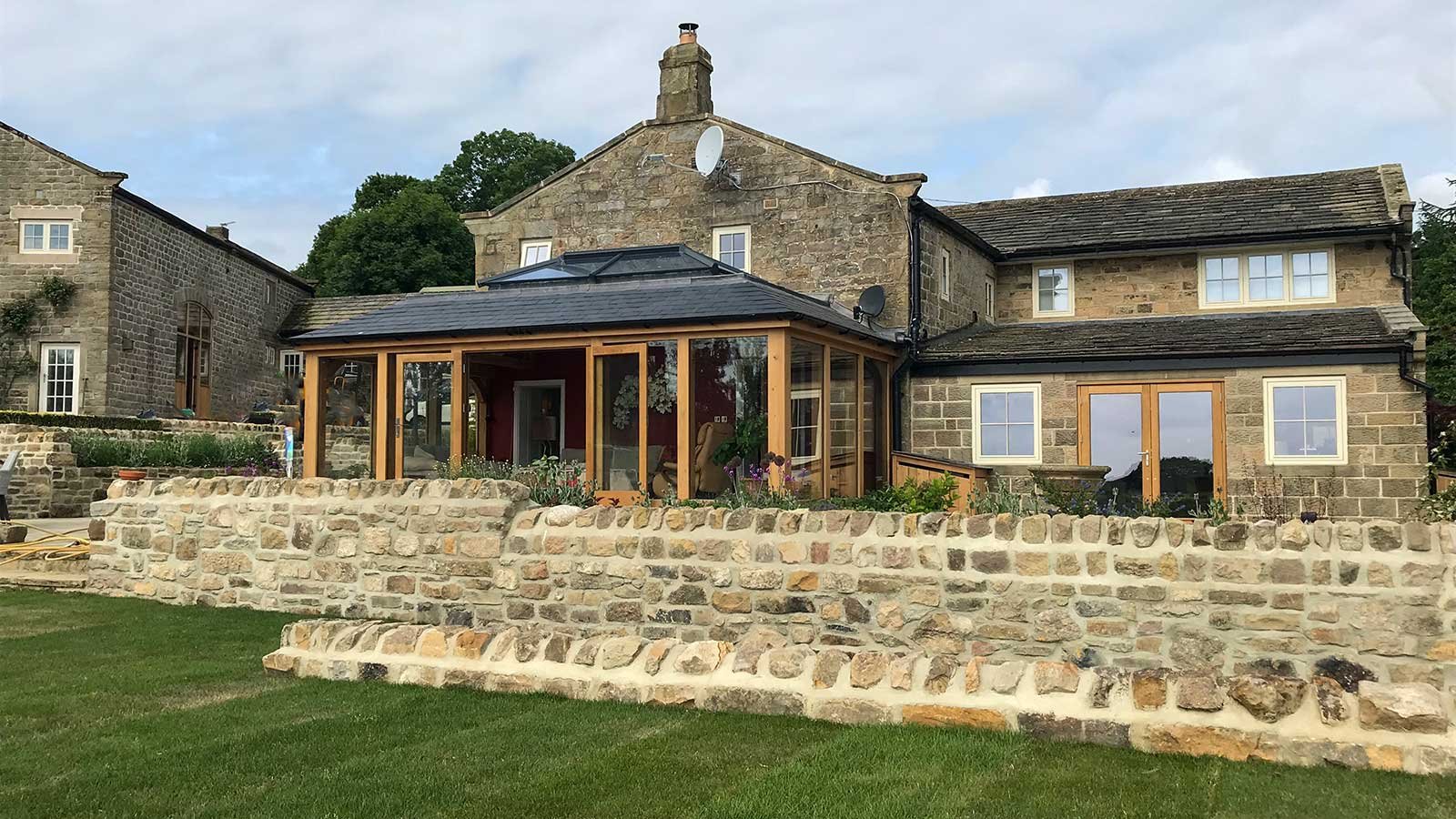
oakbydesign
01423 593 794


Harriet McDonald bought her present home as a project. It was to be her and her husband’s final house, their main house that they could design and get ‘just right’.
When they met Jamie from Oak By Design at the Harrogate Home Building and Renovating Show they had a concept of how their new home would look; it would need to include an oak orangery
Sited in a beautiful village on the outskirts of Harrogate with views over the Washburn Valley and period property, it needed renovating and extending sympathetically.
With planning permission in place, the brief was to add an oak orangery, with a lantern roof, to the end of the property to realise the benefit of living in beautiful countryside. The oak building was to lead out onto a stone patio for summer days and evenings.
Bespoke oak doors and frames were made to suit the non-standard doorways in the property. Glazed doors and screens used to bring light into the oak building.
In the room next to the new oak sunroom, a pair of oak French Doors ensures more light stream through the house and these match the oak of the framework, creating a seamless look externally.
All the external oak work was finished with 2 coats of oak RSJ covers for above the staircase and in other areas, along with oak flooring.
The Oak By Design installation team worked alongside Harriet’s builders ensuring the build progressed as quickly and efficiently, and cleanly as possible.
Harriet found working with Jamie and the team very enjoyable due to their problem-solving attitudes together with a ‘can do’ approach to the whole scheme.
Harriet and her family now enjoy their beautiful new home, and it comes into its own during the summer months.
The patio, filled with family and friends enjoying the beautiful landscaped, country garden and the outstanding countryside beyond, provides the perfect setting in summer. In the colder months, the large glazed doors and windows ensure the countryside is still appreciated.
Harriet especially loves the hidden cupboard behind the staircase, one of the many designs working together with Jamie created. It is a firm favourite with everyone who sees it!
Oak conservatories have emerged as a quintessential architectural addition, elegance and sophistication. This timeless structure seamlessly blends with any landscape, augmenting the aesthetics of both traditional and contemporary settings. The unparalleled charm of oak conservatories lies in their ability to harmonise with nature, creating a sanctuary that encapsulates tranquility.
One notable advantage of oak conservatories is their exceptional durability. Crafted from robust oak timber, these structures exhibit remarkable strength, ensuring longevity that surpasses conventional building materials. The solid construction not only withstands the test of time but also serves as an enduring testament to masterful craftsmanship.
Moreover, oak conservatories offer an abundance of natural light through their expansive glazing panels. These ethereal spaces become sanctuaries bathed in a soft luminosity during daylight hours, fostering a connection with the outdoors while providing an immersive experience within the comfort of one's home.
Furthermore, oak conservatories seamlessly merge indoor and outdoor living spaces, offering a seamless transition between the two realms. This spatial integration fosters a sense of harmony and unity between architecture and nature—a symphony where boundaries dissolve into nothingness.
In conclusion, oak conservatories are more than mere architectural marvels; they embody an embodiment of grace and beauty that transcends time. Their durability, ability to invite abundant natural light, and seamless merging of indoor and outdoor spaces make them an exquisite choice for those seeking to create a haven within their homes—a sanctuary where one can escape the chaos of everyday life and immerse themselves in serenity offered by nature's embrace.
Air-dried oak, a type of timber that undergoes a natural drying process, offers notable advantages in construction projects. This article aims to highlight the benefits of using air-dried oak and its superiority over green oak, particularly in terms of stability and reduced risk of movement and shrinkage.
One anecdote vividly illustrates the stability offered by air-dried oak. Imagine constructing two identical wooden benches, one made from green oak and the other from air-dried oak. As time passes, seasonal changes introduce fluctuations in humidity levels. The green oak bench absorbs moisture during humid periods, causing it to swell and potentially warp or crack. In contrast, the air-dried oak bench remains relatively unaffected due to its lower moisture content. This highlights how air-drying reduces the risk of movement and instability associated with green oak.
Research indicates that green oak typically has a moisture content ranging from 60% to 80%, while air-dried oak boasts significantly lower levels due to natural drying processes over several years. On average, air circulation aids in reducing the moisture content by approximately 25mm per year for exterior timbers.
In conclusion, when considering timber options for construction projects, it is crucial to recognize the superiority of air-dried oak over green oak regarding stability and reduced risk of movement or shrinkage. The anecdote presented above serves as a clear metaphor for understanding this distinction visually. Moreover, data points reinforce these observations by highlighting significant differences in moisture content between these two types of timber. By choosing air-dried oak, builders can ensure long-lasting structures that resist warping or cracking caused by environmental fluctuations and maintain their structural integrity for years to come.
Double glazing, also known as a double glazed sealed unit (DGU), is a window consisting of two panes of glass separated by a spacer bar. The air gap between the glass panes is filled with an insulating gas, creating a thermal barrier that enhances energy efficiency within buildings. This article explores the primary benefit of double glazing - thermal insulation.
One notable advantage of double glazing is its ability to provide thermal insulation in buildings. By retaining heat within a room and preventing cold air from entering, double glazing contributes to enhanced energy efficiency and reduced heating costs.
The construction of a DGU involves sandwiching two sheets of glass with an insulating gas-filled gap. This configuration acts as a barrier against heat transfer, significantly reducing the amount of warmth lost from indoor spaces during colder months. Conversely, it prevents external cold air from infiltrating indoors and disturbing the desired temperature levels.
Furthermore, the presence of an insulating gas within the double glazed unit enhances its thermal performance. Commonly used gases include argon or krypton, which have low conductivity properties compared to regular air. As such, they minimize heat transfer through conduction across the insulated space between the glass panes.
In conclusion, double glazing offers significant advantages for buildings by providing effective thermal insulation through its unique design and composition. By retaining heat indoors and preventing cold air infiltration, it promotes energy efficiency while reducing heating costs. Incorporating double glazed units into windows can enhance comfort levels within rooms and contribute to sustainable building practices overall.
Telephone: 01423 593 794
Locksley Park
Blind Lane
Tockwith
YORK YO26 7QJ
Opening Times:
Mon to Fri - 9.00am to 5.00pm
Bank Holidays - Closed
Christmas 2025- TBC
Oak By Design is the trading name of:
Oak By Design Ltd.
Reg Number: 04384416
VAT Number: 664 8012 33